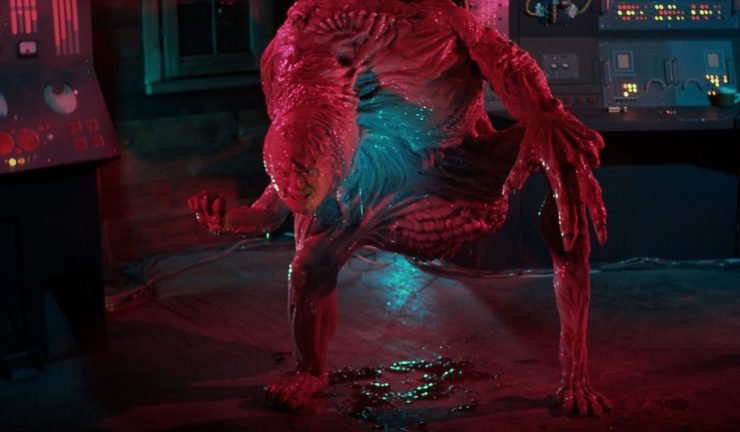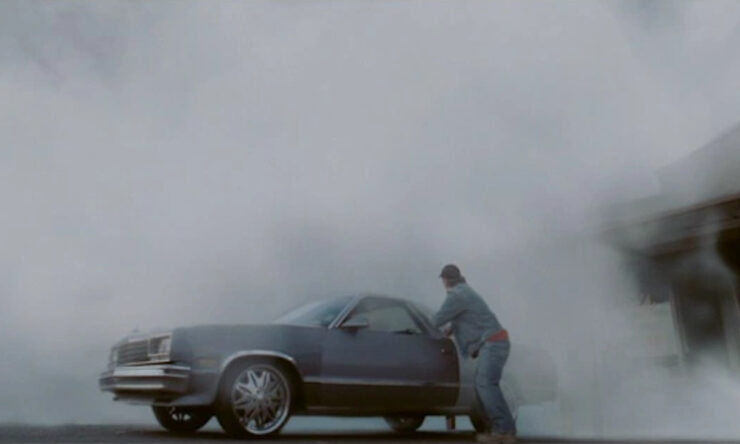Welcome back to Reading the Weird, in which we get girl cooties all over weird fiction, cosmic horror, and Lovecraftiana—from its historical roots through its most recent branches.
This week, we celebrate Post #350 with the 1986 From Beyond film, loosely adapted from H.P. Lovecraft’s story of the same title by Brian Yuzna & Dennis Paoli; Screenplay by Dennis Paoli; directed by Stuart Gordon. Spoilers ahead, and content warnings for implied sexual assault, deeply non-consensual on-screen groping and mind control, and a lot of people getting their heads bitten off/brains eaten.
“Humans are such easy prey.”
Dr. Edward Pretorius has invented the Resonator, designed to reveal latent senses by stimulating the pineal gland. We meet his assistant Crawford Tillinghast engaged in late-night tinkering in the attic laboratory. The Resonator’s “tuning forks” emit a fuchsia energy field in which Tillinghast “sees” a foot-long translucent eel gyrating—and latching onto his cheek. He deactivates the Resonator, and the eel vanishes.
Summoned from bed, Pretorius reactivates the Resonator. He shivers in ecstatic agony. Eager for more novel sensation, he refuses to turn it off. Something is coming, he says.
The attic windows blow out. A neighbor calls the cops, then chases her dog Bunny into Pretorius’s house. Shouts lead her to the attic door. An ax-head punches through. Tillinghast follows. Both flee, leaving Bunny nosing Pretorius’s headless body.
Police haul Tillinghast to Dr. Bloch’s psychiatric hospital. Detective Jordan Fields brings Dr. Katherine McMichaels to examine Tillinghast. Bloch’s sceptical of McMichaels, a “girl wonder” known for controversial experiments with schizophrenics. McMichaels orders a scan of Tillinghast’s brain. When it shows that his pineal gland is greatly enlarged, she convinces Fields to let her and Tillinghast replicate the Resonator experiment.
Fields assigns Sergeant Bubba Brownlee to babysit at the lab. Brownlee and McMichaels view Pretorius’s room, packed with BDSM paraphernalia and, um, home videos—the genius professor was into some weird shit, Brownlee opines. (Tillinghast will later recount how he used to lie awake listening to the women that Pretorius wined, dined… and then made scream.) In the attic they find Tillinghast reliving how he axed the Resonator—something from beyond beheaded Pretorius!
Tillinghast reactivates the device. McMichaels is affected like Pretorius; she and Tillinghast experience a trance of mutual lust, broken when a nude Pretorius appears. He didn’t die, he explains, but passed beyond. Tillinghast touches Pretorius’s shoulder, malleable as clay. It’s just a body, Pretorius explains: changeable, while the mind is indivisible. To demonstrate, he peels off his face. Brownlee shoots him, and his head erupts into a geyser of grasping flesh. Tillinghast switches off the Resonator, banishing Pretorius.
Tillinghast nixes McMichael’s idea of repeating the experiment, but he’s swayed when she recounts her father’s suffering from schizophrenia (and accompanying institutionalization). If the illness results from an enlarged pineal gland that lets people see these horrors, the Resonator could lead to a cure.
All sleep restlessly that night. McMichaels yields to the Resonator’s pull, half-sleepwalking to turn it on. It, in turn, turns her on; when Tillinghast appears the two struggle, then embrace fiercely. Then Pretorius returns. He seizes McMichaels, while Tillinghast runs to cut the power. Brownlee joins him, but the Resonator field has “let in” a giant lamprey-toothed worm that swallows Tillinghast whole. Meanwhile Pretorius “kisses” McMichaels, by which he means swallowing her head to absorb her brain.
Brownlee kills the power. A remorseful McMichaels tends the wounded (now hairless) Tillinghast in Pretorius’s den. Brownlee goes to pack. McMichaels relapses into Resonator-deranged sensuality, dons a skimpy black leather outfit, and straddles Tillinghast. Brownlee returns, and she switches her seduction to him. Brownlee forces Tillinghast to look in an overhead mirror. She snaps out of her fugue-state.
Before they can leave, Pretorius-Thing activates the Resonator from beyond. The three rush upstairs to deactivate it, but bee-creatures attack Tillinghast and McMichaels. Brownlee lures them away and is gnawed to death. Pretorius arrives, more inhuman than ever, an antenna-like eye-stalk/pineal worm protruding from his forehead. He urges Tillinghast to surrender to change. Tillinghast struggles, but as an antenna bursts from his own forehead, he “sees” in new colors. McMichaels gets hold of a fire extinguisher and sprays down the Resonator, disabling it.
Buy the Book


Summer Sons
The survivors end up back at Bloch’s hospital. Detective Fields leaves a ranting McMichaels in Bloch’s resentful hands, and Bloch orders immediate electroshock therapy. While McMichaels is prepped, Tillinghast escapes from his room, hungry. He devours Bloch’s brain.
In the confusion, McMichaels slips away. Tillinghast also escapes via stolen ambulance.
McMichaels returns to Pretorius’s house with a bomb. She attaches it to the Resonator, timed for five minutes. Tillinghast cuts off her escape and shackles her in Pretorius’s den. As he goes for her brain, she bites off his antenna-stalk. The amputation returns Tillinghast to himself in time to face off against Pretorius. He taunts the monster: if it shares telepathic “pleasure” with McMichaels, she’ll know he’s weak and impotent! Enraged, Praetorius chases him and consumes his head.
McMichaels lures Beyond-eels to chew through her shackles. With Pretorius blocking the stairs, she runs to the attic. The timer stands at 30 seconds, and Pretorius is on her heels, laughing. Suddenly hands protrude from his mouth—Tillinghast clawing his way out. Clutched in one of the monster’s appendages, McMichaels witnesses Tillinghast’s suicidal battle. Both entities are degrading, disintegrating. Finally they’re two skulls biting each other, then liquifying mess. The bomb-timer’s at two seconds when McMichaels leaps out a window.
Her fall leaves her with a compound leg fracture. Drawn by the explosion, neighbors gather. The dog-lady asks what happened. McMichaels can only gasp out “It—ATE—him!” before lapsing into mad screaming laughter.
What’s Cyclopean: Only minimal attempts to describe the unnamable here: “We saw creatures!” “It bit off his head. Like a gingerbread man.”
The Degenerate Dutch: Black dude dies first. Also, for a movie where all the named women have doctorates, that sure was a lot of uncomfortable lingering on women getting felt up by extremely un-sexy monsters.
Weirdbuilding: Tillinghast is not much like the original character in “From Beyond,” stuck as a postdoc(?) rather than initiator of brain-breaking research. He has a good reputation from Miskatonic, but Benevolent Street and therefore presumably the Pretorius Foundation is in Providence, not Arkham.
Libronomicon: Pretorius collects oil paintings and American flags, but weirdly for an interdisciplinary researcher doesn’t appear to have a lot of books.
Madness Takes Its Toll: By 1986, Dr. Bloch’s asylum is in deep violation of several laws regarding minimal restraint. It also appears to be badly understaffed and lacking in furniture. Its residents, and most of the main characters at one time or another, are in violation of any attempt at realistic depiction of trauma and mental illness.
Ruthanna’s Commentary
Not to get serious about an 80s gorefest, but this is one of many reasons why you should report big name researchers for sexual harassment and assault. If Crawford had just told someone about his advisor’s non-consensual dungeon, the resonator would’ve remained unfinished and none of this would’ve happened. Lesson 1.
Lesson 2 is about not calling the cops on your neighbors, because if Crawford had had a few minutes to collect his wits and call relevant authorities himself, instead of being tackled as he ran from the house’o’slime, none of this would have happened. Lesson 3 is about always submitting your neuropsych research to the Institutional Review Board. And Lesson 4 is about the importance of psychiatric deinstitutionalization, despite its vast imperfections, because if Bloch’s asylum had been following actual mid-80s psych practice and staffing guidelines, some of this might still have happened but probably fewer people would have gotten eaten by pineal worms.
Anyway, boy, that sure was an extremely 80s movie. Not that you can even count in 2021 on characters getting eaten in non-standard order, or on the beautiful mad scientist avoiding leather bondage gear, but there was absolutely no attempt here to even pretend Bubba wasn’t going to die first. Which is a pity, because he was extremely sensible and our three protagonists actually would have made a pretty good team when not being mind controlled by… have I mentioned that this is what happens when you let physicists do neuroscience? This is what happens when you let physicists do neuroscience; it always ends badly.
So I like Bubba, his ability to resist the lure of pineal stimulation and his focus on getting everyone out alive, even if he isn’t successful. I’m also unreasonably fond of McMichaels, who feels like a very McGuire-ish sort of mad scientist in the making. Sure, she has a sympathetic backstory reason for wanting to cure schizophrenia and provide an alternative to institutionalization, but she also has a gleeful willingness to experiment on whoever’s handy that makes you wonder how she’s previously avoided machines requiring 20,000 volts to power up. Plus she’s in favor of experimental replication, which is really very important. Crawford’s sympathetic but bland: his character arc consisting of growing a spine at about the same rate he grows a pineal worm, and then dying of the combination.
Lesson 5 is never sleep in the house.
There was, I feel, a period in the 80s going into the 90s when the only approved way to titillate audiences with kinky stuff was to underline very clearly that it was always terrible and non-consensual. It’s notable that we never actually get explicit evidence that Pretorius’s dungeon encounters weren’t agreed to on all sides, it’s just kind of assumed that we’ll assume it. Clearly post-beyond Pretorius is a horrible stalker monster, but the resonator also makes McMichaels dress up for the camera, so this does not by itself say anything about his earlier predilections. It’s obviously artistic intent and I’m willing to go with “asshole the whole time,” but I’m kind of side-eyeing the whole plot thread. One is left with the logical inference that all human eroticism results from extradimensional incursions. Lovecraft admittedly might have agreed, if he’d somehow not run out of the room the first time someone gets an orgasm from exposure to invisible fish.
I did, by the way, look up Arthur Yuwiley, the movie’s pineal gland consultant. He appears to have been an expert in serotonin and melatonin (he passed away in 2012), and this is the only time he ever consulted on a movie. I hope he was pleased, or at least amused, with the result.
Anne’s Commentary
The New York Times runs a regular feature in its Sunday book review section called “By the Book.” In it, writers answer set questions, including the ever-popular “Which writers, living or dead, would you invite to a dinner party?” I’ll put a spin on the question, changing it to “Which writers, living or dead, would you invite over for a movie night, where the films du soir would be adaptations of their works?”
After watching this week’s weird offering, my answer would be immediate: I’d reanimate Lovecraft and present him with the 1986 version of his “From Beyond.” I’d make sure to have plenty of ice cream on hand to compensate him for the probable trauma of this viewing experience, although who knows. The sheer effrontery of the adaptation might amuse him. At least he could have fun noting such insider-joke details as the address of Pretorius’s house (666 Benevolent Street) and Crawford Tillinghast’s choice of sleepwear (a Miskatonic University T-shirt.) He wouldn’t be impressed by the sense of place developed. From Beyond wasn’t shot in Providence, or anywhere in New England, for that matter: To save big production bucks, the film was made on an Italian soundstage outside Rome. The very few “exteriors” look it, especially that, um, Benevolent Street address.
Never mind the lack of local atmosphere, though I always do mind it. Howard’s “From Beyond” is one of his early works (1920, though not published until 1934), a perfectly innocent little parable about the hazards of scientific/metaphysical curiosity pushed too far, into that territory humanity is not meant to plumb. Whereas Stuart Gordon’s From Beyond might today earn the alternate title of “Fifty Shades of Fuchsia.”
Speaking of fuchsia, From Beyond supplies more evidence that it’s a leading contender for the multiverse’s most eldritch color, right up there with putrid green and jaundiced yellow. When the special effects guys need to indicate that an energetic emission is not of our world, out of Space or out of Dimension or out of Time even, some noxious blend of purple and pink is sure to get the nod. The tuning forks of the Pretorius Resonator pulse in fuchsia, and that fuchsia glow in the attic windows is part of what sends Fluffy Dog Neighbor to the phone to summon the authorities. Those men in 666 Benevolent must be up to no good if their lampshades are productive of that hue.
I wonder whether she and the other neighbors have ever heard the screaming that keeps poor Crawford awake whenever his boss brings a date home. I guess not. Nobody ever mentions it. File this with other improbable plot points I noticed, like the lead detective in the Pretorius murder case letting McMichaels waltz his chief suspect out of safe custody and back to an unsealed crime scene, even with an ex-football player holding their leashes. And like McMichaels knowing where to buy or how to make a fairly sophisticated explosive device on extremely short notice. And, if one stops to think about it, like most of the characters’ decisions, whether on practical or ethical grounds.
Time to face the Real Monster in the room, who is Edward Pretorius. Per IMDb trivia for From Beyond, his character was based on Dr. Septimus Pretorius, Henry Frankenstein’s evil mentor in The Bride of Frankenstein (1935). Ted Sorel’s Edward does look a lot like Ernest Thesiger’s Septimus, especially in the hair department. Septimus Pretorius’s implied but carefully undisclosed psychosexual situation is that he’s gay—Bride’s openly gay director James Whale told Thesiger to play him as an “over the top caricature of a bitchy and aging homosexual.” Edward Pretorius’s only-too-blatant psychosexual situation is that he’s an over the top caricature of a bitchy and aging sexual sadist. We’re left to suppose by Crawford’s eleventh-hour revelation that Pretorius was driven by impotence-frustration. Poor guy, he had to substitute a whip for an erection. Just the person to donate a brain to Something From Beyond, giving it a human persona that would justify the moviemakers’ apparent desire to push their film as close to an X rating as possible without giving up the less prohibitive R rating it eked out.
At least they did cut the opening scene of Pretorius hammering a nail through a woman’s tongue. No wonder he looked pissed off when Crawford banged on his door—no one likes to be interrupted in the middle of a victim-improvement project.
I’m not going to elaborate on my dislike for how McMichaels transforms from a buttoned-up, tightly braided, eyeglass-wearing librarian, er, psychiatrist to a wild-maned, scarlet-lipsticked, leather-bikinied sex kitten because pineal gland stimulation. And I’ll give the movie phallic-phoolery points for those pineal eye-stalks, various suggestive extrusions from the Pretorius-Thing, and the tight briefs so closely matched to Brownlee’s skin color that he looked like he was running around with his full frontals on full display.
What do you say, Howard? Should we watch Lovecraft Country instead? Or maybe The Bride of Frankenstein for some nice wholesome fare….
Next week, we still don’t know which of these scary books is the scary book, but we know the answer is going to be bad for everyone involved. Join us for Chapter IV, sections I-VIII, of John Connolly’s Fractured Atlas.
Ruthanna Emrys is the author of the Innsmouth Legacy series, including Winter Tide and Deep Roots. Her short story collection, Imperfect Commentaries, is available from Lethe Press. You can find some of her fiction, weird and otherwise, on Tor.com, most recently “The Word of Flesh and Soul.” Ruthanna is online on Twitter and Patreon, and offline in a mysterious manor house with her large, chaotic household—mostly mammalian—outside Washington DC.
Anne M. Pillsworth’s short story “The Madonna of the Abattoir” appears on Tor.com. Her young adult Mythos novel, Summoned, is available from Tor Teen along with sequel Fathomless. She lives in Edgewood, a Victorian trolley car suburb of Providence, Rhode Island, uncomfortably near Joseph Curwen’s underground laboratory.













